Consumer Insights Tracker – July to September 2025 Report
1. Key findings
Key findings for July to September 2025:
-
Food affordability: Close to a quarter (23%) of respondents were worried about being able to afford food in September 2025. This is in line with the previous quarter, for example, in June and May, the figure was 22%.
-
Money saving behaviours: In September 2025, the most common behaviours respondents reported doing to save money, out of those listed, were eating food past its use by date (63%) and eating leftovers that have been kept in the fridge for more than two days (63%). This is consistent with the last quarter.
-
Food concerns: In September 2025, food prices (91%) remained the top concern, followed by ultra-processed food (78%) and food waste in the supply chain (77%). The top concerns have remained broadly consistent over time.
-
Food Standards Agency (FSA): Among respondents with some knowledge of the FSA, the proportion who trust the FSA to do its job is at 63% in September 2025. Over the quarter, trust remained consistent (62-63%), following a trend of increasing trust observed between December 2024 (57%) and May 2025 (66%).
-
Precision breeding: 16% of respondents had heard of precision breeding in September 2025. Respondents were more accepting of precision breeding of plants (46%) than animals (27%). Attitudes towards precision breeding of animals have remained relatively stable since March 2024, however attitudes towards precision breeding of plants have varied over time.
-
Precision fermentation: In August 2025, more respondents said they had heard of ‘fermentation’ (79%) than ‘precision fermentation’ (20%) or ‘precision-fermented dairy’ (16%). The proportion who were willing to include precision fermented dairy in their diet decreased slightly from February (31%) to August 2025 (28%).
2. Background and methodological information
2.1. Survey topics
This report presents findings for topics we track regularly including consumer concerns in relation to food, food affordability, and confidence in the FSA as a regulator. The core questions in this survey underwent review before the launch of the April 2025 survey. Some new questions and/or statements were introduced, resulting in a new timeseries for some questions/ statements. Please see the notes on each slide for further information.
Between July and September 2025, questions were also asked about consumer views on food supplements (July), precision fermentation (August), precision breeding (September) and glycerol (August and September). Findings on precision fermentation and precision breeding can be found in this report. Data for all topical questions can be found in the accompanying data tables.
2.2. Method
-
This research was conducted online using the YouGov panel which gives access to 400,000 active panel members in the UK.
-
This report presents findings from July – September 2025. Where appropriate, comparisons are made to previous waves since July 2023.
-
Across England, Wales and Northern Ireland 2,283 people took part in the survey in July (4th – 9th), 2,201 in August (1st – 5th) and 2,050 in September 2025 (5th – 9th).
-
Quotas were set by age, gender, education and region. The data is also weighted to be representative of the population by these demographic variables. All results are based on final weighted data.
2.3. Notes for interpretation
-
Reporting convention (↑ / ↓ on graphs): The Consumer Insights Tracker uses t-tests to assess differences over time and between groups, and highlights those where the p value is <0.05. Due to the quota sampling methodology used this is not an exact test of whether differences are statistically significant and indicative of real changes in wider population. However, they may highlight where there could be shifts in behaviour or attitudes and further research would be required to assess if these changes are real.
-
Online panel survey: As respondents are selected from an online panel, people without internet access are not represented.
-
Percentages: Figures may not add up to 100% on graphs due to figures being rounded to the nearest whole number, or because in some questions, respondents were able to select multiple answers. In some cases, rounding may make changes appear smaller or larger than they are in the underlying data. Statistical tests have been conducted using the unrounded figures.
3. Results
3.1. Food affordability
Figure 1 shows the proportion who reported worrying about their household not being able to afford food remained stable in July (21%), August (23%) and September 2025 (23%), comparable to levels in June (22%).
As shown in Figure 2, the most common behaviours respondents reported doing to save money, out of those listed, were eating food past its use by date (63%) and eating leftovers that have been kept in the fridge for more than two days (63%). This is consistent with the last quarter.
3.2. Food concerns
In September 2025, food prices (91%) remained the top concern, followed by ultra-processed food (78%) and food waste in the supply chain (77%), as shown in Figure 3. The top concerns have remained broadly consistent over time.
3.3. The Food Standards Agency
As shown in Figure 4, trust in the Food Standards Agency (FSA) remained stable between July and September 2025 (62%-63%). The upward trend in trust seen from December 2024 (57%) has plateaued from May 2025 (66%).
3.4. Food safety topics
Although awareness of different food safety topics has varied month to month, the topics respondents were most likely to have been aware of across July to September 2025 were food recalls (30-35%), food hygiene ratings (27-29%) and food allergies and intolerances (20-24%), as shown in Figure 5.
Across the quarter, respondents most commonly said they had seen, read or heard something about any of these topics in the news (52%) on social media (38%) and via word of mouth (24%).
3.5. Precision breeding
In September 2025, 16% of respondents had heard of precision breeding, however only 5% of respondents reported knowing what it is (as shown in Figure 6). Levels of awareness were higher than in March 2025 (13%) but comparable to September 2024 (18%) and March 2024 (17%).
As shown in Figure 7, respondents were more accepting of precision breeding of plants (46%) than animals (27%) in September 2025. Attitudes towards precision breeding of animals have remained relatively stable since March 2024 (26-29% acceptance), however attitudes towards precision breeding of plants have varied over time (43%-50% acceptance).
3.6. Precision fermentation
In August 2025, whilst most respondents (79%) had heard of the term ‘fermentation’ a minority had heard of ‘precision fermentation’ (20%) or ‘precision-fermented dairy’ (16%), as shown in Figure 8. Awareness of all three terms decreased between February 2025 and August 2025.
Figure 9 shows in August 2025 respondents had mixed views on whether precision fermented dairy should (27%) or should not (34%) be on sale in the UK in the future, as in February 2025.
In August 2025, more respondents were not willing (43%) to include precision fermented dairy in their diet than were willing (28%), as shown in Figure 10. The proportion who were willing has slightly decreased since February 2025 (31%).
In August 2025, safety was considered the most important factor when deciding whether to buy precision fermented food (85%), followed by proper regulation (82%), as shown in Figure 11. Factors considered least important were environmental consideration (68%) and recommendations from trusted people (60%).
4. Further information
-
visit our Consumer Insights Tracker webpage
-
or please contact the FSA’s Analytics Unit
Acknowledgements
FS code FS900280

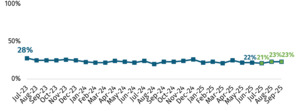
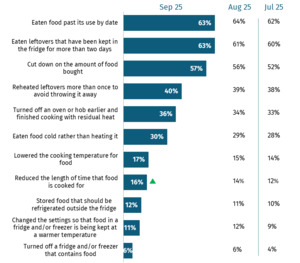
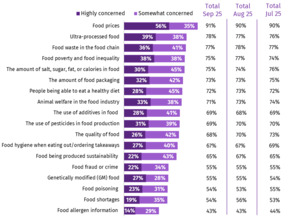
.png)
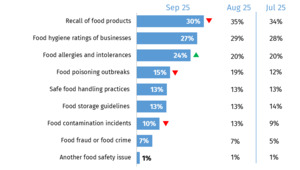
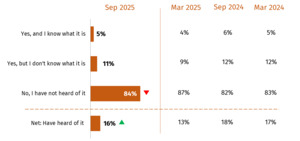
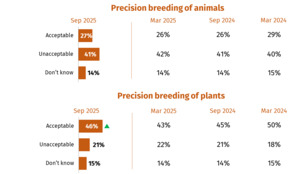
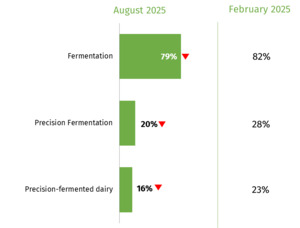


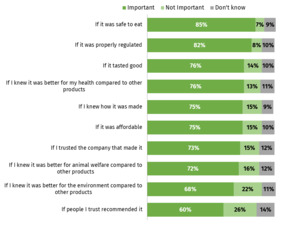



.png)






